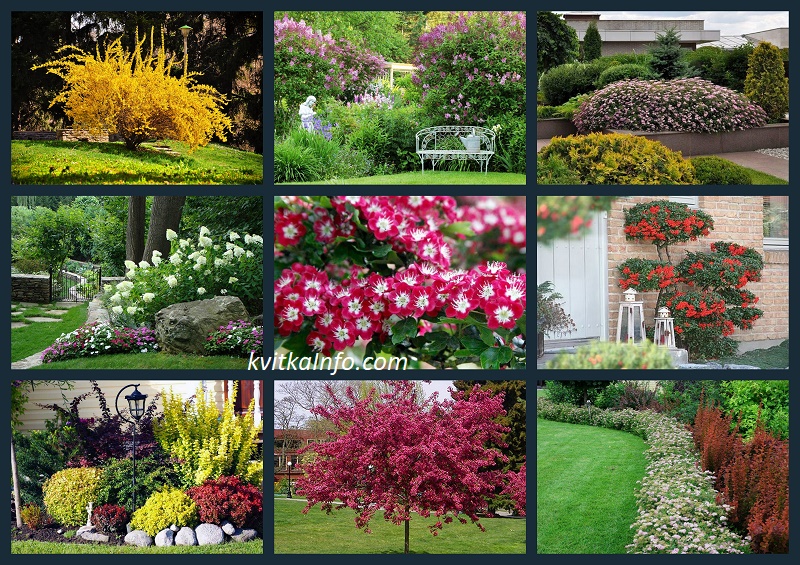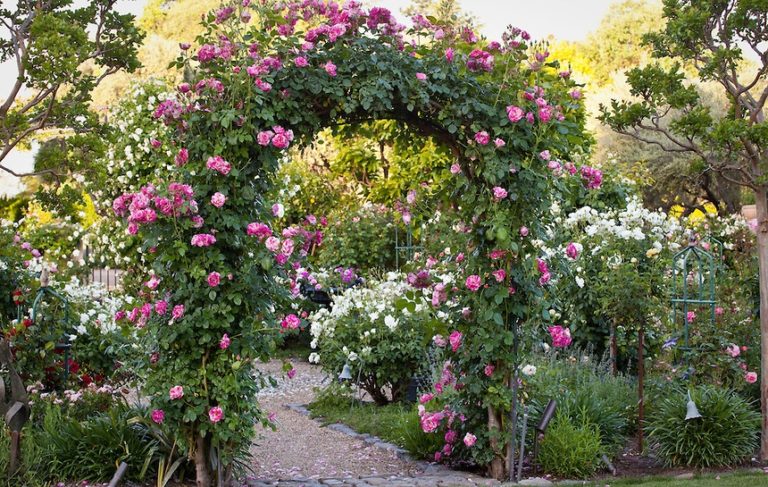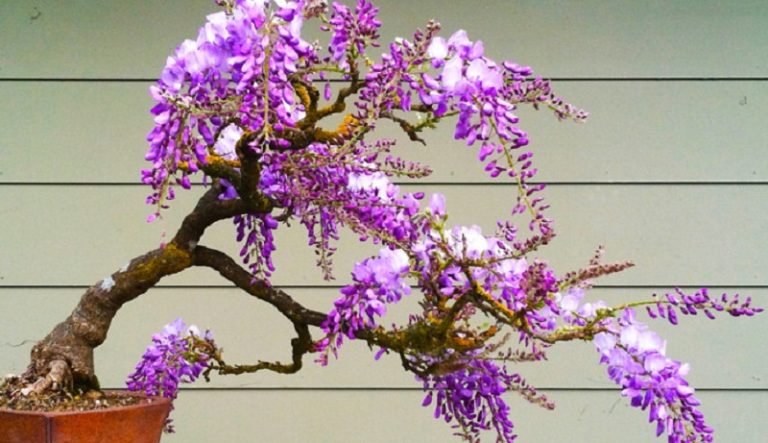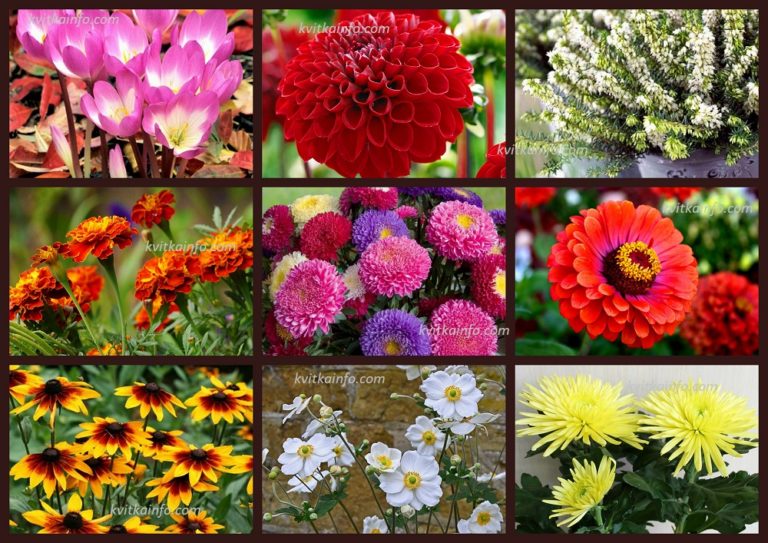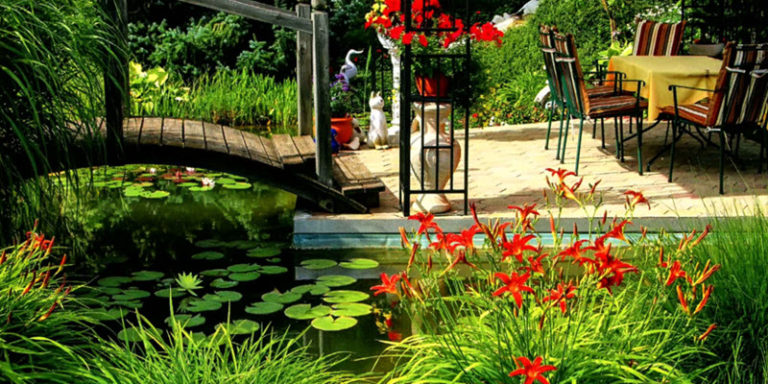Unpretentious flowering shrubs that should be planted on your site. Part 1
To make your garden interesting, fun, bright and colorful throughout the year, it is also worth planting ornamental shrubs. It is practically unnecessary to care for such bushes, they bloom and make bright spots in the landscape design of the garden from spring to autumn.
By planting unpretentious ornamental shrubs, you will give your garden a variety of colors throughout the year. These ornamental shrubs can completely replace a flower garden. But it is worth remembering that so that the bush does not lose its neat appearance, it needs to be trimmed in spring or autumn.
Отже, kvitkainfo.com склала рейтинг 10 невибагливих кущів, які є декоративними 4 сезони:

1. Forsythia
Forsythia is the first flower of spring, as soon as it snows and the sun begins to warm up the earth – lush forsythia bushes bloom. The most common color of forsythia is bright yellow, but more recently, pink and white flower colors have appeared. Forsythia hedges look very beautiful – the first month of spring, the kush blooms with yellow flowers, and then green leaves grow, through which nothing is visible, so forsythia is an excellent hedge. It must be remembered that this bush is deciduous.
How and where to plant forsythia? How to care for forsythia? You will find answers to these questions in the article “FORSYTHIA: PLANTING, CARE”.

2. Lilac
After forsythia, lilacs bloom. Lilac is the most common ornamental shrub that is found in almost every yard. Its aroma is the smell of spring. A variety of species and varieties today allows you to choose a bush that will satisfy all whims – lush flowers of rich color, and rich foliage, and the size of the plant allows you to plant it even in a small garden. Lilacs can also be considered a good, but deciduous, hedge.
How and where to plant lilacs? How to care for lilacs? You will find answers to these questions in the article “LILAC: PLANTING, CARE”.
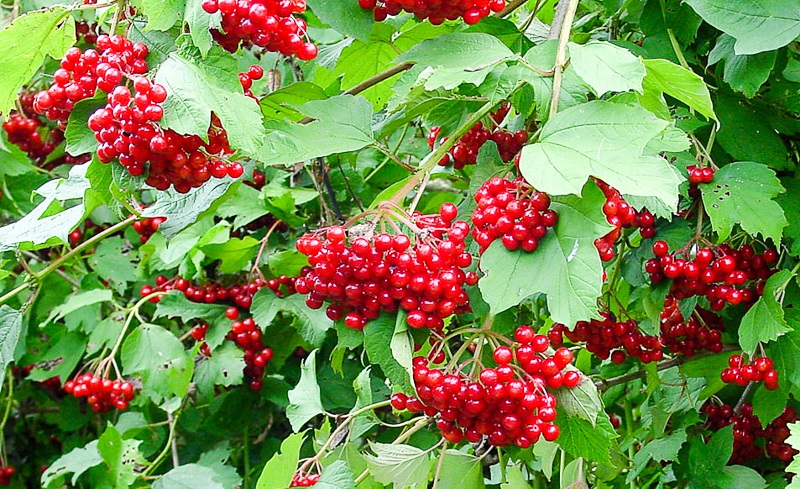
3. Viburnum
Viburnum is one of the symbols of our Ukraine. The value of viburnum lies in: 1 flowering bush in spring, viburnum is planted in singly and in groups, including together with other ornamental shrubs and trees, conifers; 2 In autumn, the foliage changes color from bright green to crimson red, turning the viburnum bush into a real highlight of the garden at any time of the year, and in winter it is valued for its red, healing edible berries that stand out brightly in the white snow. The genus of viburnum includes more than 200 species. There are those that do not have edible fruits, but very decorative leaves. There are even evergreen viburnum bushes.
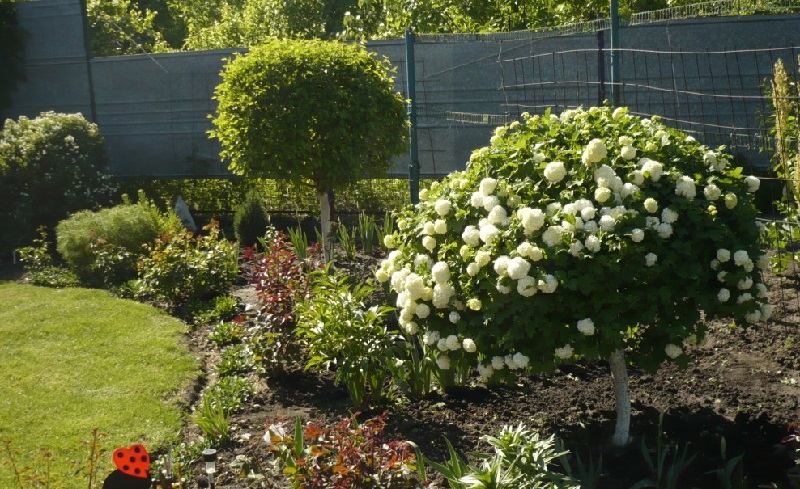
4. Decorative viburnum – “Boule des Neiges”
Often in the courtyards of Ukraine there is a large spreading bush covered with white spherical flowers, this is buldenezh or viburnum, rosarium, or decorative viburnum.
Translated from French, “Buldenezh” means “snowball”. And the plant got this name not by chance. This viburnum blooms with large flowers collected in spherical inflorescences, and the whole bush is covered with huge, up to 15-20 cm in diameter, snow-white balls.
The flowering duration of decorative viburnum is 25-35 days, so it looks great both in group and single plantings. “Buldenezh” looks especially impressive in standard form and near water bodies and against the background of fences and evergreens.
How and where to plant ornamental viburnum? How to care for ornamental viburnum? You will find answers to these questions in the article “DECORATIVE VIBURNUM – PLANTING, CARE, REPRODUCTION”.
5. Barberry
Landscape designers are very fond of using barberry in their designs, for its unusual decorative effect at any time of the year, they are planted both in separate plantings, they are also planted in groups, and used as a hedge. Barberry is easy to cut, which makes it one of the best shrubs for topiary art.
Barberry is beautiful throughout the year, it is not for nothing that it is called a plant of 4 seasons. In May, the bushes are strewn with small yellow flowers collected in clusters. All summer months, the bush pleases the eye with bright green leaves, and some ornamental varieties with variegated, yellow and burgundy decorations. Autumn is the time for leaf discoloration, but bright red clusters of berries remain on the branches until next spring.
Barberry is also used for hedges, in a few years the barberry grows so much that it becomes a dense, impassable obstacle in the garden. Non-deciduous bushes are best suited for this.
How and where to plant barberry? How to care for a barberry? You will find answers to these questions in the article “BARBERRY: CULTIVATION, CARE”.

6. Pyracantha
Pyracantha is a thorny evergreen shrub that is ornamental throughout the year and does not need to be cared for. In spring, it blooms with white flowers, and after flowering, fruits are formed, which become bright in autumn, and look great on white snow in winter. Such a bush must necessarily grow in a flower garden or singly in the garden. The decorativeness of this shrub lies in the fact that it blooms magnificently and bears fruit abundantly. Luxuriantly flowering bushes are attractive to bees, and the fruits of this plant are pecked by birds.
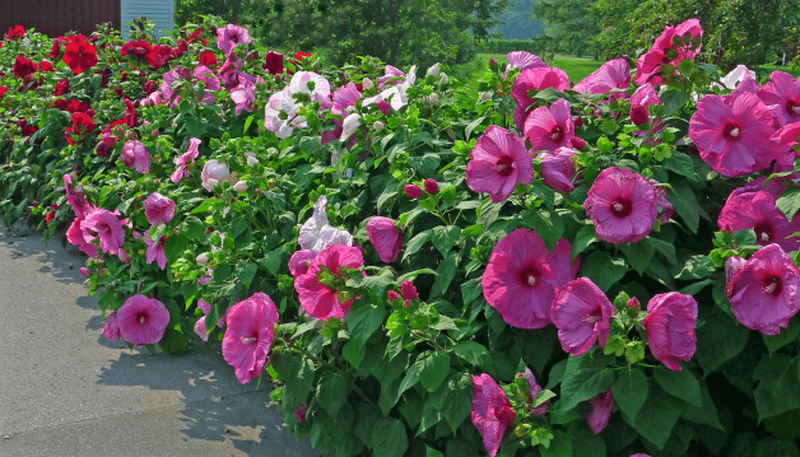
7. Hibiscus
Syrian hibiscus and herbaceous hibiscus belongs to the Malvaceae family. It is valued for its large, beautiful flowers of various shades that bloom from July to September, and for its unpretentious care.
Hibiscus will decorate any landscape design. Some ornamental shrubs of this species grow up to three meters, so you can make an excellent hedge from such Syrian hibiscus. You can also use hibiscus to divide the site into zones. To maintain the decorative effect of the bushes, they need to be trimmed every year, otherwise they will have an untidy appearance. It should be noted that herbaceous hibiscus die off the ground for the winter, and with the onset of spring they grow again.
Tip: Shorten long branches by half so that they do not bend.
How and where to plant hibiscus? How to care for hibiscus? You will find answers to these questions in the article ” HIBISCUS: CARE, TRANSPLANTATION, REPRODUCTION”
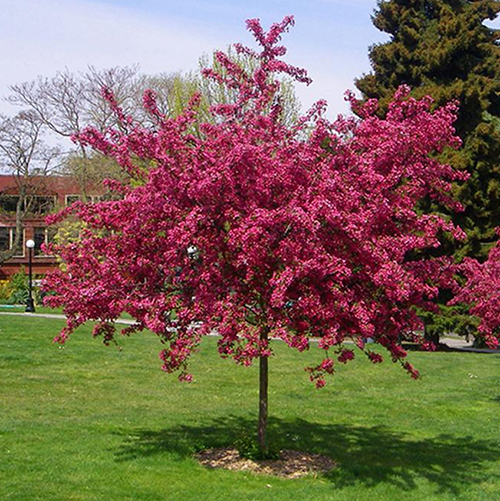
8. Hawthorn
Hawthorn is an ornamental shrub because of its bright green and shiny foliage in spring and summer, bright orange, yellow and crimson shades in autumn. Hawthorn blooms from late May to mid-June, but smells unpleasant. Flowers, depending on the variety, can be double or simple, snow-white, pale pink or red-pink. They are collected in dense or loose inflorescences. Red berries ripen in September or October. Therefore, hawthorn can grow both in single plantings and in group ones. It is worth noting that hawthorn berries are edible and birds love them in winter. Decorative hawthorn is unpretentious in care, after planting it quickly takes root, resistance to drought and frost has provided the shrub with high popularity among gardeners.
Tip: You need to plant hawthorn in a sunny area, because for the flowering and fertility of hawthorn, it needs to be in the sun for at least six hours a day. Prefers loose permeable soils. Indeed, with the right place for planting, it practically does not require care.
9. Spirea
Spirea is a perennial shrub with lignified branches, which has recently become especially popular among amateur gardeners. Spirea is often found in city parks, because it is a completely unpretentious plant and does not require special care, and different varieties can create a stunning composition. Spirea is suitable for hedges, it grows quickly and, with proper care, remains decorative for decades.
How and where to plant spirea? How to care for a spirea? You will find answers to these questions in the article “SPIREA: PLANTING, CARE, PRUNING, REPRODUCTION”.

10. Hydrangea
Hydrangea (Hydrangea)is a very beautiful perennial non-capricious plant, valued in gardening for its variety of colors and shapes of inflorescences. It looks spectacular both in group and in single plantings on a green background. Abundant flowering of hydrangea in summer will give your site a beautiful and unusual look: on one bush you can see inflorescences of different colors.
Hydrangea belongs to the hydrangea species (Hydrangeaceae). The genus has up to about 100 species of hydrangea that grow in East and South Asia, North and South America, most species are found in China and Japan.
Hydrangea flowers, depending on the species, are collected in inflorescences in the form of a ball, an elongated ball, an umbrella; The leaves are large, oval, with wavy or serrated edges. The variety of colors of inflorescences is simply amazing. Inflorescences can be either monochromatic or two-colored: white, pink, dark pink, red, lilac, blue, crimson. The color of hydrangea flowers depends on the acidity of the soil: pink colors appear on alkaline soils, and blue colors appear on acidic soils, but it cannot be said that all hydrangeas change color.
How and where to plant hydrangea? How to care for hydrangea? You will find answers to these questions in the article” HYDRANGEA: PINK OR BLUE? CARE “.

